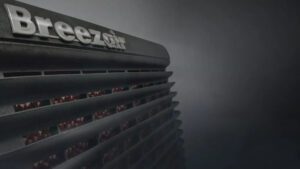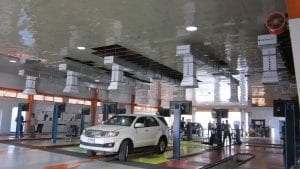Environmentally Friendly Air Conditioning
- Australia
- Residential
- Sustainability, Cooling
Evaporative cooling vs Refrigerated systems
Lower electricity usage
Evaporative air conditioners use far less electricity compared to refrigerated systems therefore, less fossil fuels such as coal and natural gas are consumed in the production of electricity. Investing in a premium evaporative air conditioning product will not only deliver lower running costs, but will also reduce energy network demands and lower the carbon footprint of a household as a result. The only power-consuming components of an evaporative cooler are the fan, electronic control and a small water pump. As a result, evaporative cooling running costs are low, using up to 80 per cent less energy than refrigerated air conditioning*** which means less fossil fuels such as coal and natural gas are consumed in the production of electricity.
How a carbon footprint can be reduced by evaporative air conditioning
A carbon footprint is the total set of greenhouse gas emissions that an individual or organisation causes*. Usually, when measuring a carbon footprint, it is in terms of the amount of carbon dioxide directly or indirectly produced. If a household appliance uses a low level of electricity it minimises the environmental impact.
Better for the environment and better for you
Every time a customer chooses an evaporative cooler over a refrigerated cooler, the benefits for the environment are significant. For example the Australian manufactured Breezair evaporative cooler, has been shown to produce about ** 20% of the carbon emissions produced by a standard refrigerated air conditioning system. In fact, evaporative coolers are one of the most environmentally friendly methods of cooling available, because evaporative cooling is based on a natural technology.
Evaporative cooling systems contain no harmful synthetic refrigerants. The other benefit of evaporative cooling that perhaps isn’t as obvious is that it doesn’t recirculate air; it continually pumps 100% fresh cooled air through your home.
Refrigerated cooling re-circulates the same air inside your home, and uses chemicals which can damage the environment. In comparison, evaporate cooling is based completely on natural processes, using water to cool, with no chemicals involved. The air is never re-circulated, and is constantly replaced with fresh air – meaning your eyes and throat won’t become irritated and people with respiratory and health issues can enjoy their time indoors.
Evaporative cooling reduces demand on the energy network
The comparison between evaporative and conventional refrigerated air conditioning is just as significant when it comes to the bigger picture – the electricity network. We already know that energy use and therefore evaporative running costs are much lower than for refrigerated air conditioning, which in turn means those with evaporative cooling aren’t drawing on the electricity network as much.
By choosing energy efficient evaporative cooling such as a Braemar, Breezair or Coolair unit, you can help reduce the amount of harmful greenhouse emissions entering our environment!
Evaporative Cooling RangeReferences:
* www.aquaculture.org.nz/wp-content/uploads/2011/06/Carbon-Footprinting.pdf
**Based on data published by Sustainability Victoria website April 2018 http://www.sustainability.vic.gov.au/You-and-Your-Home/Save-energy/Cooling/Cooling-running-
costs
*** Based on approximate running costs figures from publicly sourced data. Based on 2-star house in a Melbourne climate, cooling all day on the weekend and in the morning and evenings when internal temperatures are high. Based on an electricity tariff of 27.5c/kWh. Note evaporative coolers also use water.
Tagged: eco friendly air conditioner, eco friendly air conditioning, environmentally friendly air conditioner, environmentally friendly air conditioning



